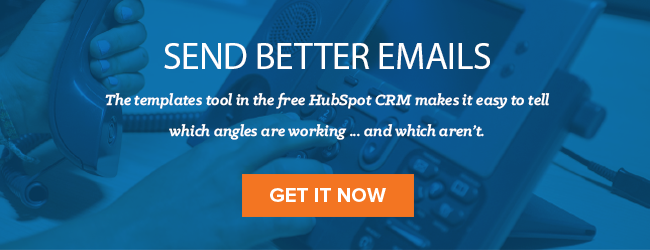Communication is the lifeblood of sales. Successfully closing deals, providing value, explaining complexities -- they all rely on your ability to express yourself clearly and persuasively.
The sales email is a special breed of communication. You only have a very small window of opportunity to capture your reader’s attention and convince them to move one step closer toward a purchase. Use these writing techniques to ensure your emails pack the most punch.
10 Persuasion Techniques to Apply in Your Sales Emails
1) Know your audience
Okay, so this isn’t exactly a writing tip. But it’s the foundation upon which your email’s effectiveness is built. If you don’t understand your audience -- whether it’s the prospect who’s hesitant to buy, or the happy customer you’d like to upsell -- you won’t be able to write persuasively.
2) Social proof
Why it works: Social proof describes the tendency to make choices based on other people’s decisions, because we believe those decisions reflect the right choices.
Marketing teams already leverage the concept of social proof through customer case studies and displaying customer or social share counts.
How to use it: Reference high-profile customers or the size of your customer base. For a more targeted use, point out how many of your prospect’s competitors and peers use your product.
Examples:
- The McDonald’s slogan “Billions and billions served” calls out the company’s giant customer base.
- Yelp’s success is a result of its user-generated content: Crowdsourced reviews that leverage the power of social proof.
3) Get your foot in the door with a small ask
Why it works: Once a prospect says “yes” to a small ask -- the proverbial foot in the door -- they’re more likely to agree to future requests.
How to use it: Ask your prospect a question that they are unlikely to say no to.
Examples:
- If you sell software that tracks target accounts’ trigger events, an easy way to get a first “yes” is to confirm that your prospect’s sales team wants to improve their prospect outreach.
4) Include a headshot in your email signature
Why it works: When we make eye contact with people, we feel a subconscious sense of connection. In one Cornell University study, researchers edited images of the Trix rabbit mascot, then asked adults to pick between several cereal boxes bearing different versions of the image. Participants most often chose the box where the rabbit was directly looking at them.
How to use it: You can’t make actual eye contact through email, and by no means should you include a massive photo of yourself in the body of an email -- that’ll just make prospects uncomfortable.
But it can be easy to forget that there’s a person on the other end of your emails. Including a small headshot of yourself in an email signature is a subtle way to remind prospects that you’re human too.
5) Agitate and solve
Why it works: Just because your prospect is aware they have a problem in one area or another doesn’t mean they’re prepared to solve it.
But emotion is a powerful thing. Whether it’s subconscious attachment to the old way of doing things causing inertia, or fear of making the wrong decision, your prospect won’t always warm to your product immediately.
To convince them, you’ll often have to talk about the problem in emotional terms, then swoop in with a solution to demonstrate how you can help.
How to use it: While you should never attempt to over-exaggerate a business pain or spin one out of thin air, use the agitate-and-solve technique when it’s clear they haven’t fully conceptualized the cost of inaction.
Find out what matters to your prospect. Is it personal professional achievement that drives them forward? A desire to grow the business’ bottom line? Then show how inaction will only worsen their current situation, and demonstrate why your product would help.
Example:
- An office supply salesperson could seek out its competitors' clients who had been impacted by late shipments. She should probe into the significance of these delays, getting prospects to talk through the immediate and ripple effects. Then, she can describe her own company's efficient service and customer support.
6) Include a reason why
Why it works: Giving people a reason why you need something -- no matter how ridiculous -- makes it far more likely they’ll do what you ask.
Psychologist Ellen Langer conducted a study in which experimenters asked to skip ahead in line at a Xerox machine. When they asked, “I have five pages. May I use the Xerox machine?”, they were allowed to skip the line 60% of the time -- not a bad outcome.
But when they asked, “I have five pages. May I use the Xerox machine because I have to make some copies?”, 93% were allowed to skip the line.
Despite the fact that everyone else in the Xerox machine line needed to make copies, they complied with the request simply because the experimenters provided a reason.
How to use it: We wouldn’t recommend making up ridiculous excuses to get your prospects to sign a contract -- that’s not good for anybody. But even providing a simple explanation -- “I’d like to set up a meeting with you because I can help with X strategy” -- could pay huge dividends.
Example:
- Instead of writing, "I'd like to set up a conversation so we can discuss your project management software strategies," try this instead: "I'd like to set up a conversation to discuss your marketing strategy because we've seen similar companies increase their lead generation by 40%."
7) Remind prospects it’s their choice
Why it works: Nobody likes to be told what to do -- especially when the person telling them to do something is a salesperson. And even if you’re not being pushy or aggressive, many prospects will still chafe at the suggestion that you know what’s best for them.
A simple reassurance that you’re not attempting to push your preferences or worldview onto your prospect is powerful. Across 42 psychology studies involving 22,000 subjects, it’s been demonstrated that using a phrase like “But the decision is yours” could double the chances that someone would say yes to a request.
How to use it: You don’t want to overuse this one -- tempering every recommendation you make by reminding prospects they have no obligation to listen to you isn’t a great idea. But when you’re asking for a larger commitment or are dealing with a jumpy prospect, dropping in a reminder that you’re not here to force them into anything can be a powerful technique.
Example:
- A software salesperson could write this message to a prospect skittish about switching platforms:
When we last spoke, you mentioned that you were worried about migrating your system from your current tool to ours. Sales Engineer Sally put together this high-level overview of the process, which is designed to be as easy on our customers as possible -- we can discuss this on our call tomorrow. In the meantime, based on our previous conversations I strongly believe this switch is the best long-term solution for your company -- but of course, the decision ultimately rests with you. Let me know what you think."
8) Use assertive language
Why it works: Prospects want to know what will happen to their business and their own professional brand if they buy from you. If you communicate in a way that makes it seem like you can only potentially deliver value, you'll automatically become less persuasive.
The amplification hypothesis provides the science behind this phenomenon. Researchers found that increased "attitude certainty," or the sureness with which you express a belief, can actually change other people's attitudes toward that value. This works both proactively and reactively: Speaking about your product's benefits with certainty will strengthen your prospect's belief that it'll be effective, while responding vaguely to a prospect's expression of doubt can help weaken their objections.
How to use it: Obviously, you should never be evasive about objections that require a legitimate response or guarantee a result you know isn't certain. But cull qualifiers or weak language where they don't serve any purpose, and ensure your writing is crisp and assertive so certainty permeates your emails.
Example:
- Instead of writing, "You mentioned that your close rates are lower than you'd like, so let's schedule some time to discuss your sales process. I think I'll be able to make two or three solid recommendations for how to move forward," try: "You mentioned that your close rates are lower than you'd like. We should schedule some time to discuss your sales process. Once I learn more about how you follow up with a lead, I'll recommend an approach that'll ensure nothing is slipping through the cracks."
9) Be a little funny.
Why it works: According to a study from researchers at the University of Oxford and the University College London, laughing puts people at ease and makes them likelier to open up. That might be why we usually feel closest to our funniest friends.
Laughter is also associated with lower stress, a stronger immune system, and general happiness.
How to use it: Lightening the mood will help your prospect trust you and give you sensitive details about his company, its financial state, pain points, and business strategy, as well as his professional ambitions and anxieties. You've also got a better shot of hearing back when you crack a joke or two. With that in mind, add a funny GIF, image, or line.
Example:
- Your prospect mentions loving House of Cards in their bio, so you use a Kevin Spacey meme.
10) Use "ultimate terms."
Why it works: Certain words carry good or bad connotations powerful enough to influence action. According to Changing Minds, ultimate terms fall into three categories: "God words," which have positive connotations, "Devil words," which have negative ones, and "Charismatic terms," which fall under neither good or bad but are words associated with intangible, observable phenomena (like "progress.").
Also known as "power words," these terms invoke basic needs in either a positive or negative way to appeal to the reader. Find a full list at Changing Minds.
How to use it: Don't overdo it -- lists of power words have been widely circulated for years, and any prospect who's ever seen a billboard will know exactly what you're doing if you use power words in every sentence.
Example:
- Use power words sparingly before or in a request where it'll pack the most punch. For example, get a prospect who thinks buying software will render his position redundant to come around by writing that new technology will empower him to work on more long-term, strategic projects.
How do you make your sales emails more persuasive? Let us know in the comments below.
This post was originally published in January 2016 and has been updated for comprehensiveness and accuracy.
Persuasion in Sales




.jpg)



